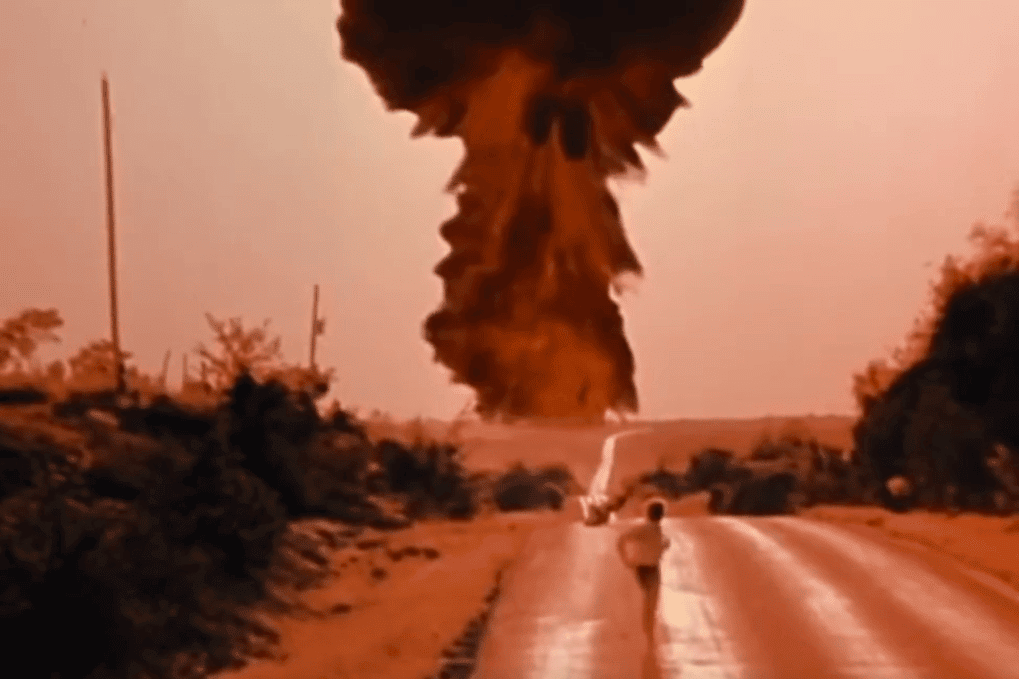Making the threat of nuclear war personal: An exercise
By Herbert Lin | March 7, 2024
 A scene from the film 'The Day After' (1983) about the effects of a devastating nuclear holocaust on small-town residents of eastern Kansas. (Credit: American Broadcasting Companies, Inc.)
A scene from the film 'The Day After' (1983) about the effects of a devastating nuclear holocaust on small-town residents of eastern Kansas. (Credit: American Broadcasting Companies, Inc.)
In 2020, the International Committee of the Red Cross commissioned Ipsos, a firm that conducts market research and public opinion surveys, to examine the views of millennials on “the most important issues affecting people around the world today.”[1] Only two issues were named by the majority of millennials—corruption (54 percent) and unemployment (52 percent). Global warming ranked eighth on the list of concerns, at 40 percent.
Of interest for this short note: Concern over nuclear weapons ranked last, at 24 percent. The finding is quite surprising, especially given that the same poll found that over half of the same millennials—54 percent—believe it is likely that a nuclear attack will occur in the next decade. A more recent poll (in 2023) found 56 percent of millennials believing that they did not know enough about nuclear weapons to assess the benefit or harm to them personally.[2]
These polls give some support to the frequently made observation that nuclear war is far down on the concerns of millennials. Colleagues have offered a variety of possible explanations: They believe that earlier generations solved the problem since there hasn’t been a nuclear war or even the threat of a nuclear war in their experience; there’s nothing they can do about it in any case; it’s too technical to understand the issues; they don’t understand international rivalries between great powers; the topic is too triggering for today’s students to grapple with (more on this point later).
In the hope of countering this lack of concern and knowledge, I have taught for a number of years a course at Stanford University known as “Technology and National Security.” This course devotes substantial attention (about 50 percent of the course) to nuclear weapons, both the technology and policy associated with this topic. The nuclear portions of the syllabus would not be surprising to Bulletin readers—there are lectures on the history and basic physics of nuclear weapons and delivery systems, nuclear weapons effects, nuclear command and control, nuclear strategy and doctrine. At appropriate places, the course draws contrasts with non-nuclear weapons, both conventional and emerging.
I also ask students to complete a variety of problem sets, one of which relates to nuclear weapons effects and targeting. The problem on weapons effects makes use of the online nuclear explosion simulator NUKEMAP. NUKEMAP allows the user to enter the parameters of a nuclear explosion, including yield, height of burst, and geographical coordinates. NUKEMAP then outputs some of the effects of that explosion—different contours of overpressure, thermal radiation, nuclear radiation, and fallout. Most important, based on its own internal data, it generates estimates of expected fatalities and injuries.
One exercise involving NUKEMAP begins with questions probably well-known to many instructors who teach about nuclear weapons. Students are asked to choose a city that they know well, perhaps their hometown or a city they have visited often. They are further asked to investigate the effects of a nuclear airburst at the center of that city for a Hiroshima-sized weapon and then for one eight times larger. They are asked to calculate the areas of different types of destruction (blast, thermal, and radiation) corresponding to different intensities and then the number of immediate and long-term fatalities and injuries resulting from each destructive process.
The next part of the question asks students to assume the larger, 120-kiloton explosion occurs at noon on a Wednesday. They are asked to provide a list of the names of some of the people that they know personally who would probably die, either immediately or within a week or two, and also to identify some of the buildings and structures they have visited that would be destroyed in such a blast.
For many students, answering this part of the question is the first personal contact they have had with the consequences of a nuclear war. Anecdotally, I have found that this exercise is the one that they remember from the course, even after several years. Every student to whom I have spoken has remarked upon the emotional impact of this question, and for some students, their reaction to the question has sometimes been an important factor in their decision to pursue additional courses or internships that address some aspect of nuclear security.
A few observations are worth making. First, there is some tension between my pedagogical intent to make students feel uncomfortable and distressed about the prospect of nuclear war and a prevailing sentiment on campus that students should not be upset by any of the material that they study. The latter is not part of any stated university policy, but the administrators and staff in the dean’s office[3] who are charged with providing support for students in the university environment strongly recommend that faculty provide trigger warnings when the nature of the subject material students are about to encounter may make them feel uncomfortable or upset.
I do in fact provide such a warning to students, first as part of the general introduction to the course and in the syllabus, and secondly as part of the problem set handout itself. From time to time, a few students push back on the suitability of the assignment, arguing that material requiring a trigger warning should be regarded as optional. These students apparently believe that a course addressing, among other things, the large-scale death and destruction that would accompany nuclear war should be presented without upsetting or disturbing material that they must study. This view is apparently endorsed by the dean’s office, which explicitly advised me to offer an alternative assignment that would not be as personally triggering.
Second, I am not entirely immune to such pressures, despite my convictions. I last taught the course in the fall of 2023, and I had initially assigned October 10 as the due date the problem set including this question. Of course, the Hamas terrorist attack in Israel occurred on October 7. In light of this horrific event, I made optional the exercise on “listing the names of people you know who would die in a nuclear explosion above your chosen city,” noting that the then-present circumstances of the world were just too gruesome to require students to complete this part of the problem set and acknowledging that some students were confronting the reality of war in news reports, phone conversations, social media posts, and a variety of other channels.
Third, even though I had made this part of the problem set optional, nearly half of the 100 students in the class answered it anyway. In making it optional, I told students that I still believed in its pedagogical value, and I still thought it was important to understand the effects of nuclear war in a personal way. And I asked them to keep in mind that nuclear war raised the prospect of suffering 10,000 or 100,000 times as widespread as it was seen on October 7. Maybe those reflections and urgings had something to do with their willingness to do an optional exercise.
The millions of people who watched the Oscar-nominated film Oppenheimer learned important things about the history of atomic bombs and the culture of the United States at the start of the Cold War. But because the movie focused on the trials and tribulations of J. Robert Oppenheimer, those viewers were not exposed to much about the effects of nuclear war—effects that should horrify us today.
Nuclear war is fundamentally upsetting and disturbing by its very nature. Antiseptic treatments of the material—displayed as tables of fatality numbers in spreadsheets or overpressure contours on maps—have a reasonable place in a nuclear education curriculum. But those details are easily forgotten in the long run and simply do not convey the horrors of nuclear weapons nearly as effectively as making a list of family and friends who would die in a nuclear war. The 2023 poll mentioned above found that members of the public, including students, “trust the information they receive from academics (57 percent) more than any other person or group, including the president (43 percent) and Congress (37 percent).” As an academic, I hope that my efforts to enable students to take away something of long-term value from this course are worth the price of them doing an upsetting or disturbing assignment.
[1] International Committee of the Red Cross, Millennials on War, 2020, https://www.icrc.org/en/publication/millennials-war.
[2] https://globalaffairs.org/commentary-and-analysis/blogs/generational-attitudes-new-nuclear-age.
[3] At Stanford University, the individuals with such responsibility are located within the Stanford Center for Teaching and Learning, a joint operation shared between the Office of the Vice Provost for Undergraduate Education and the Office of the Vice Provost for Graduate Education. For convenience, I use the more colloquial term “dean’s office” to refer to this center.
Together, we make the world safer.
The Bulletin elevates expert voices above the noise. But as an independent nonprofit organization, our operations depend on the support of readers like you. Help us continue to deliver quality journalism that holds leaders accountable. Your support of our work at any level is important. In return, we promise our coverage will be understandable, influential, vigilant, solution-oriented, and fair-minded. Together we can make a difference.
Keywords: NUKEMAP, Oppenheimer, Oscars, Stanford University, nuclear education
Topics: Analysis, Nuclear Weapons














